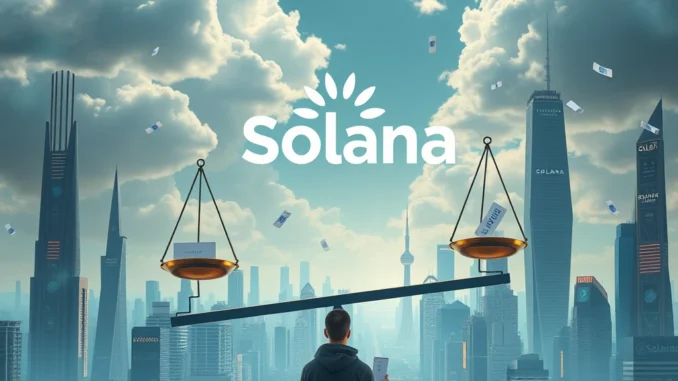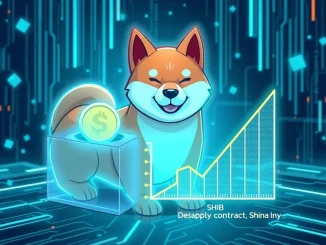
The Solana ecosystem is buzzing with anticipation as a crucial proposal, SIMD-0228, aiming to slash SOL inflation by a staggering 80%, is currently under community vote. This pivotal decision could reshape Solana’s tokenomics and potentially trigger significant shifts in the value and staking dynamics of SOL. Are Solana holders ready for a deflationary future? Let’s dive into the details of this groundbreaking proposal and what it means for the future of Solana.
What is the SIMD-0228 Proposal and Why Does Solana Need an Inflation Cut?
The SIMD-0228 proposal is a governance initiative within the Solana network focused on dramatically reducing the annual SOL inflation rate. Currently, Solana’s inflation schedule starts at 8% and is designed to decrease to 1.5% over time. SIMD-0228 proposes an immediate and substantial cut, bringing the inflation rate down by 80% from its current level.
But why is this cut being proposed? Like many cryptocurrencies, Solana utilizes inflation to incentivize network participation, particularly through staking. New SOL tokens are issued as rewards to validators who secure the network and stakers who delegate their tokens. However, excessive inflation can lead to:
- Devaluation of existing tokens: As more tokens enter circulation, the supply increases, potentially diluting the value of each individual SOL token if demand doesn’t keep pace.
- Selling Pressure: Staking rewards, often distributed in inflationary tokens, can contribute to selling pressure as stakers may sell their rewards to realize profits.
- Uncertainty and Lack of Scarcity: High inflation can create uncertainty about the long-term value proposition of a cryptocurrency, especially in comparison to assets with more controlled or deflationary tokenomics.
The proponents of SIMD-0228 argue that reducing crypto inflation is crucial for Solana’s long-term health and price stability. By making SOL scarcer, they hope to increase its attractiveness as a store of value and reduce the selling pressure from staking rewards.
Voter Sentiment: How Does the Solana Community Feel About Reduced SOL Inflation?
According to data from Dune Analytics, the initial voter response to the SIMD-0228 proposal reveals a divided community. As of the latest snapshot:
| Vote | Percentage |
|---|---|
| Support | 35.7% |
| Opposition | 17.2% |
| Abstain | 1.2% |
| Not Voted (Implied) | 45.9% |
While a significant 35.7% of voters have expressed support for the proposal, a notable 17.2% are against it. Interestingly, a large portion of voters (45.9% implied from the data) are yet to cast their votes or their votes are not yet reflected in the data. This indicates a substantial segment of the Solana community is still undecided or has not actively participated in the voting process.
The opposition likely stems from concerns about:
- Reduced Staking Rewards: Lower inflation directly translates to fewer staking rewards for validators and stakers. This could potentially disincentivize staking and impact network security if validator participation decreases significantly.
- Impact on Validator Economics: Validators rely on staking rewards to cover operational costs. A drastic reduction in rewards could make it less profitable to operate a validator node, potentially leading to centralization if only larger entities can afford to participate.
- Uncertainty about Long-Term Effects: Drastically altering tokenomics is a significant change, and some community members may be hesitant due to the unknown long-term consequences on the Solana ecosystem.
Potential Benefits of Slashing Crypto Inflation for Solana
Despite the concerns, the potential benefits of reducing SOL inflation are compelling and are likely driving the support for the SIMD-0228 proposal. These benefits include:
- Reduced Selling Pressure: As mentioned earlier, staking rewards contribute to selling pressure. Lowering inflation means fewer new tokens entering circulation as rewards, potentially decreasing the constant sell-off pressure on SOL in the market.
- Enhanced Scarcity and Store of Value Narrative: Reduced inflation can strengthen SOL’s narrative as a scarce digital asset, making it more attractive to long-term holders and investors seeking a store of value. This could lead to increased demand and price appreciation over time.
- Attracting Institutional Investors: Institutional investors often prefer assets with sound monetary policies and predictable inflation schedules. Controlling inflation could make Solana more appealing to these larger investors, bringing more capital into the ecosystem.
- Sustainable Ecosystem Growth: While inflation is intended to bootstrap network growth, a sustainable ecosystem needs to eventually transition to a model where transaction fees and other economic activities become the primary driver of validator rewards. Reducing inflation is a step towards this sustainable model.
Navigating the Challenges: Is a Drastic SOL Inflation Cut the Right Move?
The decision to cut SOL inflation is not without its challenges. The Solana community needs to carefully consider the potential downsides and ensure that the transition is managed effectively. Key challenges include:
- Balancing Staking Incentives: Finding the right balance between inflation and staking rewards is crucial. Rewards need to be attractive enough to incentivize validators and stakers to secure the network, but not so high that they lead to excessive inflation and selling pressure. The new inflation rate needs to be carefully calibrated.
- Communicating Changes to the Community: Transparent and clear communication about the rationale behind the inflation cut and its potential impacts is essential to maintain community trust and avoid confusion or panic.
- Monitoring Network Health: After implementing the inflation cut, it will be crucial to closely monitor network metrics such as staking participation, validator activity, and transaction volume to ensure that the change does not negatively impact network security or functionality.
- Potential for Short-Term Market Volatility: Significant changes to tokenomics can sometimes lead to short-term market volatility as the market adjusts to the new parameters. Solana needs to be prepared for potential price fluctuations in the immediate aftermath of the vote.
Understanding Staking Rewards and the Impact of SOL Inflation
To fully grasp the implications of the SIMD-0228 proposal, it’s essential to understand how staking rewards and inflation are intertwined in the Solana network.
In proof-of-stake (PoS) blockchains like Solana, staking is the process of locking up cryptocurrency holdings to participate in network validation and governance. Stakers delegate their SOL to validators, who are responsible for verifying transactions and maintaining the blockchain’s integrity. In return for their services, validators and stakers receive rewards, typically in the form of newly minted SOL tokens – this is where inflation comes into play.
Current Solana Inflation Schedule:
- Initial Inflation: 8% per year
- Disinflation Rate: 15% per year decrease in inflation rate
- Long-Term Inflation Target: 1.5% per year
The SIMD-0228 proposal aims to significantly alter this schedule by implementing an immediate 80% reduction in the current inflation rate. This would mean a much lower influx of new SOL tokens into the ecosystem through staking rewards.
Impact on Staking Rewards:
- Reduced APR/APY: Staking Annual Percentage Rate (APR) or Annual Percentage Yield (APY) will likely decrease if inflation is reduced. This is because a smaller pool of inflationary tokens will be distributed as rewards.
- Potential Shift in Staking Behavior: Lower rewards might lead some stakers to unstake their SOL and seek higher yields elsewhere, although the scarcity narrative and potential price appreciation could counteract this.
- Focus on Transaction Fees: As inflationary rewards decrease, the importance of transaction fees as a source of income for validators will increase. This could incentivize validators to prioritize networks with high transaction volume.
The Future of Solana and Inflation Control: A Pivotal Moment
The vote on the SIMD-0228 proposal represents a pivotal moment for Solana. It’s a clear indication that the community is actively engaged in shaping the network’s tokenomics and is willing to consider bold moves to enhance its long-term value proposition. Whether the proposal passes or not, the discussion itself is healthy and highlights the importance of ongoing governance and adaptation in the rapidly evolving cryptocurrency landscape.
If the proposal passes, Solana could be among the first major PoS blockchains to proactively and significantly reduce its inflation rate, potentially setting a new precedent for sustainable tokenomics. It could signal a shift towards prioritizing scarcity and store-of-value characteristics over high inflationary staking rewards.
However, if the proposal fails to garner sufficient support, it underscores the community’s concerns about the potential downsides of drastically reduced inflation. In this case, Solana may continue on its current disinflationary path, relying on the existing schedule to gradually reduce inflation over time.
Conclusion: A Bold Step Towards a Deflationary Future for SOL?
The Solana community’s deliberation on the SIMD-0228 proposal is a fascinating case study in decentralized governance and tokenomics. The potential SOL inflation cut is a bold move that could have profound implications for the Solana ecosystem, impacting everything from staking rewards to SOL’s market value and long-term sustainability.
As voters continue to weigh the pros and cons, the outcome of this vote will be closely watched by the entire crypto industry. It will serve as a valuable lesson in the challenges and opportunities of managing inflation in decentralized networks and the evolving preferences of crypto communities. Will Solana embrace a more deflationary future? The answer lies in the hands of its voters.



